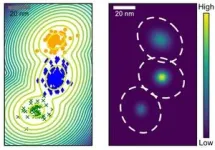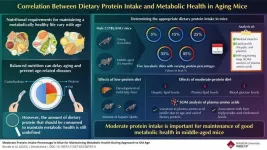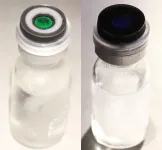(Press-News.org) New York, NY—May 31, 2023—In 2021, lanthanide-doped nanoparticles made waves—or rather, an avalanche—when Changwan Lee, then a PhD student in Jim Schuck’s lab at Columbia Engineering, set off an extreme light-producing chain reaction from ultrasmall crystals developed at the Molecular Foundry at Berkeley Lab. Those same crystals are back again with a blink that can now be deliberately and indefinitely controlled.
“We’ve found the first fully photostable, fully photoswitchable nanoparticle—a holy grail of nanoprobe design,” said Schuck, associate professor of mechanical engineering.
This unique material was synthesized in the laboratories of Emory Chan and Bruce Cohen at the Molecular Foundry, Lawrence Berkeley National Laboratory as well as in a national lab in South Korea. The research team also included Yung Doug Suh’s lab at Ulsan National Institute of Science and Technology (UNIST).
The Holy Grail: A Simple, Stable Light Switch
Existing organic dyes and fluorescent proteins used in applications like optical memory, nanopatterning, and bioimaging have yielded years of breakthroughs (and garnered a Nobel Prize in Chemistry in 2014), but these molecules have limited lifespans. Upon illumination, most will begin blinking randomly and ultimately will go dark permanently, or “photobleach.”
In contrast, lanthanide-doped nanoparticles show remarkable photostability. In over 15 years of working with them in his lab, Schuck noted they’ve never seen one die. Until one random day in 2018 when Lee and PhD student Emma Xu observed a crystal go dark, and then turn back on again. Lee dug into the literature and found 30-year-old mentions of lanthanide optical fibers that could be “photodarkened” and “photobrightened”—suggesting the blinking behavior could be controlled.
In a new paper published today in Nature, the team does just that. Using near-infrared light, they darkened and brightened their nanoparticles over a thousand times in different ambient and aqueous environments with no signs of degradation.
“We can turn these particles, which don’t otherwise photobleach, off with one wavelength of light and back on with another, simply using common lasers,” Lee said. Notably, near-infrared light can penetrate deeply into both inorganic materials and biological tissue with minimal scattering or phototoxicity.
Weird Results Brighten Future Applications
Looking towards potential applications, the team demonstrated how the particles can be used to write—and rewrite—patterns onto 3D substrates, which could one day improve high-density optical data storage and computer memory.
"This indefinite, bidirectional photoswitching nanocrystal could yield an all-optical quantum memory device for storing the vast amount of data produced by quantum computers—think of CD-ROMs and CD-RWs, but faster and much more precise,” Suh said.
The particles also offer potentially infinite resolving power, which depends on the number of photons produced by a probe under a super-resolution nanoscope. Using equipment in Suh’s lab, Lee reached sub-Àngstrom precision in only a few hours.
The team believes that photoswitching observed in the current work ultimately results from atomic crystal defects too small to be visualized even with the most advanced electron microscopes. These defects shift the particle’s avalanche threshold up or down and can be toggled by different wavelengths of light to make the signal dimmer or brighter.
In addition to pursuing potential applications in optical memory, super-resolution microscopy, and bioimaging and biosensing, the team is using nanoparticle synthesis robots at the Molecular Foundry, advanced computational models, and machine learning to improve the current crystals further and explore whether they can synthesize other kinds of nanoparticles with similar photoswitchable properties.
This entire study was a surprise, said Cohen. “We had been saying since our 2009 paper that this class of nanoparticles doesn't switch on and off, and yet that's exactly what we're studying here. One of the things we've found with these nanoparticles is to embrace weird results.”
About the Study
Journal: Nature
The study is titled “Indefinite and Bidirectional Near Infrared Nanocrystal Photoswitching.”
Authors are: Changhwan Lee1, Emma Z. Xu1, Kevin W. C. Kwock2, Ayelet Teitelboim3, Yawei Liu3,4, Hye Sun Park5, Benedikt Ursprung1, Mark E. Ziffer6, Yuzuka Karube7, Natalie Fardian-Melamed1, Cassio C. S. Pedroso3, Jongwoo Kim8, Stefanie D. Pritzl9,10, Sang Hwan Nam8, Theobald Lohmueller9, Jonathan S. Owen7, Peter Ercius3, Yung Doug Suh11, 8,12,13,*, Bruce E Cohen3,14,*, Emory M Chan3,*, P. James Schuck1,*
1Department of Mechanical Engineering, Columbia University, New York, NY, United States
2Department of Electrical Engineering, Columbia University, New York, NY, United States
3The Molecular Foundry, Lawrence Berkeley National Laboratory, Berkeley, CA, USA.
4State Key Laboratory of Rare Earth Resource Utilization, Changchun Institute of Applied Chemistry, Chinese Academy of Sciences, Changchun, China
5Research Center for Bioconvergence Analysis, Korea Basic Science Institute (KBSI), Cheongju, South Korea
6Department of Physics, Columbia University, New York, NY, United States
7Department of Chemistry, Columbia University, New York, NY, United States
8Laboratory for Advanced Molecular Probing (LAMP), Korea Research Institute of Chemical Technology (KRICT), Daejeon, South Korea
9Chair for Photonics and Optoelectronics, Nano-Institute Munich, Ludwig-Maximilians Universität München, Germany
10Department of Physics and Debye Institute for Nanomaterials Science, Utrecht University, Utrecht, The Netherlands
11Department of Chemistry, Ulsan National Institute of Science and Technology (UNIST), Ulsan, South Korea
12School of Energy and Chemical Engineering, Ulsan National Institute of Science and Technology (UNIST), Ulsan, South Korea
13Center for Multidimensional Carbon Materials(CMCM), Institute for Basic Science(IBS), Ulsan, South Korea
14Division of Molecular Biophysics and Integrated Bioimaging, Lawrence Berkeley National Laboratory, Berkeley, CA, USA
The study was supported by the Global Research Laboratory (GRL) Program through the National Research Foundation of Korea (NRF) funded by the Ministry of Science and ICT (number 2016911815), and KRICT (KK2261-12, SKO1930-20); the Office of Science, Office of Basic Energy Sciences, of the US Department of Energy under contract number DE-AC02-05CH11231; the Defense Advanced Research Project Agency (DARPA) Enhanced Night Vision in Eyeglass Form (ENVision) program (number HR00112220006); the National Science Foundation under Grant No. DMR-2019444; the NSF Graduate Research Fellowship Program; the DOE NNSA Laboratory Residency Graduate Fellowship program (No. DE-NA0003960); Programmable Quantum Materials, an Energy Frontier Research Center funded by the US Department of Energy (DOE), Office of Science, Basic Energy Sciences (BES), under award DE-SC0019443IBS-R019-D1; 2022 UNIST Research Fund (1.220108.01); seed funding support from Columbia University's Research Initiatives in Science & Engineering competition; the European Union's Horizon 2020 research and innovation program under the Marie Sklodowska-Curie grant agreement No 893439; the Fulbright Scholarship Program; the Zuckerman-CHE STEM Leadership Program; and the ISEF Foundation; the National Science Foundation under Grant No. CHE-2203510. S.D.P; the German Research Foundation (DFG) through the Collaborative Research Center 1032, Project no. 201269156, A8).
The authors declare no financial or other conflicts of interest.
###
LINKS:
Paper: https://www.nature.com/articles/s41586-023-06076-7
DOI: 10.1038/s41586-023-06076-7
###
END
A nanocrystal shines on and off indefinitely
Scientists at Columbia Engineering, Berkeley Lab, and UNIST demonstrate that ultra-photostable avalanching nanoparticles are capable of unlimited photoswitching, lighting the way for advances in optical probes, 3D memory, and super-resolution microscopy
2023-05-31
ELSE PRESS RELEASES FROM THIS DATE:
Eat right, live longer: could a moderate protein diet be the coveted elixir of youth?
2023-05-31
As the proverb “You are what you eat” goes, the type of food we consume influences our health and longevity all through our lives. In fact, there is a direct association between age-related nutritional requirements and metabolic health. Optimal nutrition according to age can help maintain metabolic health, thereby improving the health span (period of life without diseases) and lifespan of an individual. Different nutritional interventions involving varied calorie and protein intake have been known to improve the health and lifespan of rodents and primates. Furthermore, recent studies have also reported the association of dietary macronutrients (proteins, ...
How Canadians' lifestyle behaviours changed during the COVID-19 pandemic
2023-05-31
Sixty per cent of roughly 1,600 Canadians who took part in a new McGill University study say their lifestyle habits either stayed the same or improved during the COVID-19 pandemic. On the flip side, 40% of participants say they adopted less healthy lifestyle habits, including worsened eating habits, sleep quality, decreased physical activity and weight gain. The research is based on the Canadian COVIDiet study of Canadians between the ages of 18 to 89 years old. Researchers from McGill’s School of Human Nutrition collected data from across the country during the first wave of infections. ...
Researchers improved the catastrophic failure assessment of sealed cabin for ultra large manned spacecraft in M/OD environment
2023-05-31
Hypervelocity impacts of Micrometeoroid and Orbital Debris (M/OD) seriously threaten the safety of manned spacecraft and astronauts in orbit. At present, M/OD above 10 cm, which can be monitored and predicted in advance, can usually be avoided by orbital maneuver. As for the small-size M/OD, because of the difficulty of monitoring, it is the main impact threat, as well as the main object of impact risk assessment and protection design of manned spacecraft. The probability of no penetration (PNP) of the sealed cabin under M/OD impact is usually used as ...
SwRI’s Thomas Briggs receives SAE International’s Forest R. McFarland Award
2023-05-31
SAN ANTONIO — May 31, 2023 —Dr. Thomas E. Briggs, an Institute engineer in Southwest Research Institute’s Powertrain Engineering Division, has received the Forest R. McFarland Award by SAE International, an organization that works to advance mobility, knowledge and solutions for humanity’s benefit.
Established in 1979, the award serves to honor the late Forest R. McFarland, a long-time SAE International member, for his many contributions to the organization. The award recognizes outstanding contributions by volunteers who further the goals of SAE ...
A new player unveiled for lipid oxidation
2023-05-31
Overweight and obesity pose significant health risks, including an increased likelihood of developing diabetes, cardiovascular disease, and cancer. Researchers are seeking practical ways to promote the oxidation of lipids, which could help balance energy storage and consumption. A recent study has identified opioid growth factor receptor (Ogfr) gene as a promising new target for this process.
Rodents possess thermogenic fat that includes brown and beige adipocytes, which have a high capacity to uptake and utilize glucose ...
More than 80% of people who inject drugs test positive for fentanyl—but only 18% intend to take it
2023-05-31
More than 80% of New Yorkers who inject drugs test positive for the opioid fentanyl, despite only 18% reporting using it intentionally, according to a new study by researchers at the NYU School of Global Public Health.
The findings, published in the International Journal of Drug Policy, suggest that many people who inject drugs are unknowingly using fentanyl, which may increase their risk for overdose and potentially their tolerance to fentanyl if it is used over time.
In 2021, more than 100,000 people died of a drug overdose in the United States, with 66% of these deaths involving illicit fentanyl—a synthetic opioid that is 50 to 100 times more potent than morphine.
In ...
Cats can play a role in transmitting COVID-19
2023-05-31
Washington, DC – Cats can play a role in the transmission of SARS-CoV-2 and their contaminated environment (pens in this study) can be infectious, according to new research. The study was published in Microbiology Spectrum, a journal of the American Society for Microbiology.
“In practice, after introduction of SARS-CoV-2 in our household, we should see our cat as part of the family regarding virus transmission,” said study coauthor Wim van der Poel DVM, Ph.D., Professor of Emerging and Zoonotic Viruses, Wageningen University and Research, in the Netherlands.
Van der Poel and colleagues conducted the study to gain better insight ...
The secret to in-store displays: where to place discounted products relative to regularly priced products to maximize sales
2023-05-31
Researchers from University of Connecticut, Texas A&M University, University of Colorado at Boulder, and University of Florida published a new Journal of Marketing article that examines whether price promotions on some products differentially impact demand for other products depending on their relative locations within a display.
The study, forthcoming in the Journal of Marketing, is titled “The Negative and Positive Consequences of Placing Products Next to Promoted Products” and ...
Color-changing material shows when medications get too warm
2023-05-31
Some foods and medicines, such as many COVID-19 vaccines, must be kept cold. As a step toward a robust, stable technique that could indicate when these products exceed safe limits, researchers in ACS Nano report a class of brilliantly colored microcrystals in materials that become colorless over a wide range of temperatures and response times. As a proof of concept, the team packaged the color-changing materials into a vial lid and QR code.
Walk-in freezers and refrigerated trucks generally maintain their set temperatures, but ...
Metal shortage could put the brakes on electrification
2023-05-31
As more and more electric cars are travelling on the roads of Europe, this is leading to an increase in the use of the critical metals required for components such as electric motors and electronics. With the current raw material production levels there will not be enough of these metals in future – not even if recycling increases. This is revealed by the findings of a major survey led by Chalmers University of Technology, Sweden, on behalf of the European Commission.
Electrification and digitalisation are leading to a steady increase in the need for critical metals* in the EU’s vehicle fleet. Moreover, only a small proportion of the metals are ...
LAST 30 PRESS RELEASES:
UVA’s Jundong Li wins ICDM’S 2025 Tao Li Award for data mining, machine learning
UVA’s low-power, high-performance computer power player Mircea Stan earns National Academy of Inventors fellowship
Not playing by the rules: USU researcher explores filamentous algae dynamics in rivers
Do our body clocks influence our risk of dementia?
Anthropologists offer new evidence of bipedalism in long-debated fossil discovery
Safer receipt paper from wood
Dosage-sensitive genes suggest no whole-genome duplications in ancestral angiosperm
First ancient human herpesvirus genomes document their deep history with humans
Why Some Bacteria Survive Antibiotics and How to Stop Them - New study reveals that bacteria can survive antibiotic treatment through two fundamentally different “shutdown modes”
UCLA study links scar healing to dangerous placenta condition
CHANGE-seq-BE finds off-target changes in the genome from base editors
The Journal of Nuclear Medicine Ahead-of-Print Tip Sheet: January 2, 2026
Delayed or absent first dose of measles, mumps, and rubella vaccination
Trends in US preterm birth rates by household income and race and ethnicity
Study identifies potential biomarker linked to progression and brain inflammation in multiple sclerosis
Many mothers in Norway do not show up for postnatal check-ups
Researchers want to find out why quick clay is so unstable
Superradiant spins show teamwork at the quantum scale
Cleveland Clinic Research links tumor bacteria to immunotherapy resistance in head and neck cancer
First Editorial of 2026: Resisting AI slop
Joint ground- and space-based observations reveal Saturn-mass rogue planet
Inheritable genetic variant offers protection against blood cancer risk and progression
Pigs settled Pacific islands alongside early human voyagers
A Coral reef’s daily pulse reshapes microbes in surrounding waters
EAST Tokamak experiments exceed plasma density limit, offering new approach to fusion ignition
Groundbreaking discovery reveals Africa’s oldest cremation pyre and complex ritual practices
First breathing ‘lung-on-chip’ developed using genetically identical cells
How people moved pigs across the Pacific
Interaction of climate change and human activity and its impact on plant diversity in Qinghai-Tibet plateau
From addressing uncertainty to national strategy: an interpretation of Professor Lim Siong Guan’s views
[Press-News.org] A nanocrystal shines on and off indefinitelyScientists at Columbia Engineering, Berkeley Lab, and UNIST demonstrate that ultra-photostable avalanching nanoparticles are capable of unlimited photoswitching, lighting the way for advances in optical probes, 3D memory, and super-resolution microscopy







